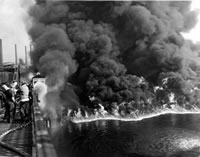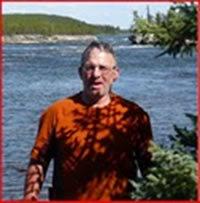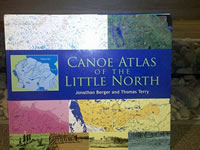
"The paint actually wore off the paddles" is how James "Doug" Barber, AR supporter since 2000, described his unforgettable trip for a high school science project on Ohio's Cuyahoga River before it, literally, burned. And sources say the river actually caught on fire at least twelve times before that. The infamous condition of the Cuyahoga at that time is described well in an excerpt from a 1968 Kent State University symposium:
"...The surface is covered with the brown oily film observed upstream as far as the Southerly Plant effluent. In addition, large quantities of black heavy oil floating in slicks, sometimes several inches thick, are observed frequently. Debris and trash are commonly caught up in these slicks forming an unsightly floating mess. Anaerobic action is common as the dissolved oxygen is seldom above a fraction of a part per million. Animal life does not exist. This entire reach is grossly polluted.
 It is generally assumed that the fire on the Cuyahoga was a bellwether event for the environmental movement and helped lead to the passage of the Clean Water Act. Doug had a unique experience, and the opportunity to view the river before and after.
It is generally assumed that the fire on the Cuyahoga was a bellwether event for the environmental movement and helped lead to the passage of the Clean Water Act. Doug had a unique experience, and the opportunity to view the river before and after.
In 1969, Doug was a high school student in Tallmadge, OH near the headwaters of the Cuyahoga. The river was always a part of the community and, as a child, Doug and his friends had played along its banks at places like Monroe Falls. But, throughout that time the condition of the river progressively deteriorated due, primarily, to industrial pollution.
Jim, bothered by the river's condition, determined to do a science fair project on the biology and chemistry of the river. One day, he gathered some friends, got a canoe, and set off for a day trip on the river. He still remembers, very well, how incredibly polluted the river was. He could see the paint falling off the paddles. Periodically, they would stop near a factory outfall, take a picture of the effluent and also gather a water sample. When they returned, Doug carefully assembled his project combining the pictures he had taken and matching them up with the respective water samples and relating all that to a map of the river.
The day of the science fair came and he was struck by just how many people were riveted by his exhibit. The samples were so foul that one lady couldn't believe what she was seeing and asked if the samples were really legitimate. Another woman asked if she could use the project afterward to help educate others about the condition of the river. Doug is very modest about the impact of the project – which won an award at the fair – but, clearly, it had a big influence on local opinion and helped increase the demand for change.
Subsequently, the Cuyahoga has become a model for how, with the proper laws, regulation, enforcement and community concern, rivers can come back. Today, the river is so much cleaner that a large part of its watershed was designated as the Cuyahoga Valley National Park. Doug, now married and with three children and a grandchild, sometimes still puts his canoe in the water and paddles the route he took for his science project, just to be sure things are still ok and to enjoy how much the river has come back. And, we know that if things ever start to slip, Doug will be right there to do something about it!
Jonathan Berger and a life of canoeing the "Little North"
"When the creek zig–zags the crocodile zig–zags" – saying in Burkina Faso. If one looks at a map in the book "Canoe Atlas of the Little North" one is struck by just how accurate this adage is. The author of the Atlas, Jonathan Berger of Philadelphia, a member of American Rivers since 1984, has spent most of his life canoeing almost every inch of this great expanse, known as the Little North –– a true wilderness –– that lies between the Boundary Waters area of the Great Lakes and Canada's Hudson Bay. Most of the time he and his traveling companion were –– truly –– off the map. So much so there were, in fact, no maps to be had. So, they created their own.
If one looks at a map in the book "Canoe Atlas of the Little North" one is struck by just how accurate this adage is. The author of the Atlas, Jonathan Berger of Philadelphia, a member of American Rivers since 1984, has spent most of his life canoeing almost every inch of this great expanse, known as the Little North –– a true wilderness –– that lies between the Boundary Waters area of the Great Lakes and Canada's Hudson Bay. Most of the time he and his traveling companion were –– truly –– off the map. So much so there were, in fact, no maps to be had. So, they created their own.
Jonathan's mother was the family canoeist, having learned to paddle in the 1920s at Camp Wapomeo in Algonquin Park in Ontario. Her great enjoyment of her time there canoeing and camping, led her to instill her own strong sense of the beauty and wonder of wilderness and water in her son Jonathan.
 As a teen, Jonathan took two–month long wilderness canoe trips in the wilds of Ontario and Quebec through the Wabun Canadian Wilderness Canoe program. Here he learned how the Voyageurs once traveled throughout Canada and the US by using traditional equipment including wood/canvas canoes, "wannigans" and tump lines. During these excursions, Jonathan fell in love with this part of the world, rivers and canoeing and started on a path that eventually led to the creation of the Atlas, which Jonathan considers his "life's work."
As a teen, Jonathan took two–month long wilderness canoe trips in the wilds of Ontario and Quebec through the Wabun Canadian Wilderness Canoe program. Here he learned how the Voyageurs once traveled throughout Canada and the US by using traditional equipment including wood/canvas canoes, "wannigans" and tump lines. During these excursions, Jonathan fell in love with this part of the world, rivers and canoeing and started on a path that eventually led to the creation of the Atlas, which Jonathan considers his "life's work."
Jonathan says the inspiration for the Atlas was that he had been carrying a "mental map" in his head of the intricate routes and portages, many of them used for hundreds of years by Voyageurs and Native Americans alike. Among the things he learned on his thousands of miles of canoe journeys over the last half–century is that wilderness canoeing has its own pace and its own set of rules and you best adhere to them, as he puts it very succinctly: "Go Slow" – Get there Fast", "Go Fast – Don't Get There At All!"
In many ways, there is a "Back to the Future" quality of his telling of his travels as, just as the Voyageurs of yore, he and his paddling companion would carry hundreds of pounds on their backs over long portages to the next river or lake on their route.
Listening to Jonathan, you can't help but share his sense of wonder for the places and the things he saw...portages marked only by trails trampled by time above a waterfall, ancient pictographs in huge "picture galleries" on bluffs towering 40 to 50 feet above the river, and the riveting names of the rivers themselves –– "The Echoing" "The Gods at Chamatowa" "Fort Hope", he gives you a great sense of the sheer scale and utter remoteness for the place and, frankly, a sense of longing to be there oneself, away from all the distractions.
Says Jonathan:
"We have spent the past five decades paddling up and down the rivers of the Little North. Numerous times we have followed the many routes across the basin divides and crisscrossed the Little North to and from the watersheds of the Great Lakes, Hudson Bay, James Bay, and Lake Winnipeg. We realize that we travel in a land of complete connection. We travel in a great rocky, sandy, bog covered, lake dotted, river cut and crossed forest filled with paths. The Little North is a forest whose roads are the waterways. The waterways are lined with rock channels through the shallows, rock art on the cliffs, cultivated wild rice beds in the marshes, blueberry grounds on the sand plains, fishing, hunting, trapping camps, and portage trails. The Little North is at once a northern forest and a northern garden."


